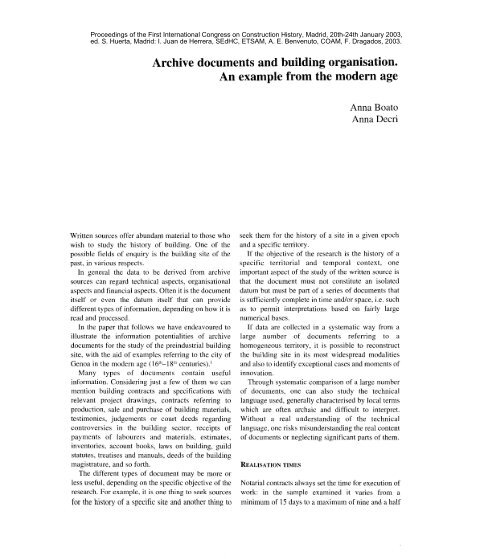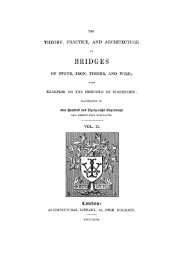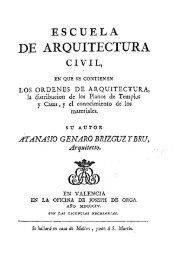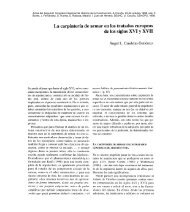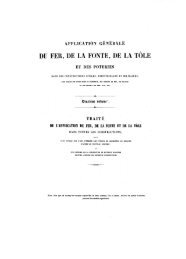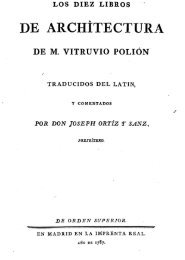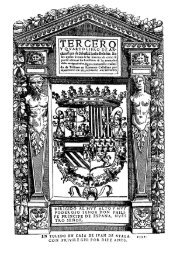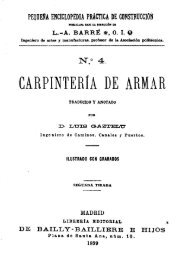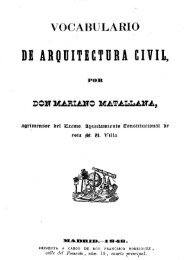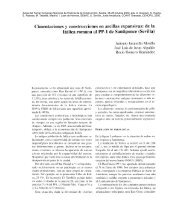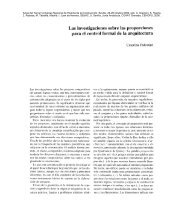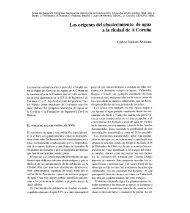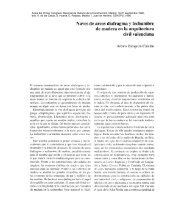Archive documents and building organisation. An example from the ...
Archive documents and building organisation. An example from the ...
Archive documents and building organisation. An example from the ...
Create successful ePaper yourself
Turn your PDF publications into a flip-book with our unique Google optimized e-Paper software.
Proceedings of <strong>the</strong> First International Congress on Construction History, Madrid, 20th-24th January 2003,<br />
ed. S. Huerta, Madrid: I. Juan de Herrera, SEdHC, ETSAM, A. E. Benvenuto, COAM, F. Dragados, 2003.<br />
Written sources offer abundant material to those who<br />
wish to study <strong>the</strong> history of <strong>building</strong>. One of <strong>the</strong><br />
possible fields of enquiry is <strong>the</strong> <strong>building</strong> site of <strong>the</strong><br />
past, in various respects.<br />
In general <strong>the</strong> data to be derived <strong>from</strong> archive<br />
sources can regard technical aspects, <strong>organisation</strong>al<br />
aspects <strong>and</strong> financial aspects. Often it is <strong>the</strong> document<br />
itself or even <strong>the</strong> datum itself that can provide<br />
different types of information, depending on how it is<br />
read <strong>and</strong> processed.<br />
In <strong>the</strong> paper that follows we have endeavoured to<br />
illustrate <strong>the</strong> information potentialities of archive<br />
<strong>documents</strong> for <strong>the</strong> study of <strong>the</strong> preindustrial <strong>building</strong><br />
site, with <strong>the</strong> aid of <strong>example</strong>s referring to <strong>the</strong> city of<br />
Genoa in <strong>the</strong> modem age (16th_18th centuries).!<br />
Many types of <strong>documents</strong> contain use fui<br />
information. Considering just a few of <strong>the</strong>m we can<br />
mention <strong>building</strong> contracts <strong>and</strong> specifications with<br />
relevant project drawings, contracts referring to<br />
production, sale <strong>and</strong> purchase of <strong>building</strong> materials,<br />
testimonies, judgements or court deeds regarding<br />
controversies in <strong>the</strong> <strong>building</strong> sector, receipts of<br />
payments of labourers <strong>and</strong> materials, estimates,<br />
inventories, account books, Jaws on <strong>building</strong>, guild<br />
statutes, treatises <strong>and</strong> manuals, deeds of <strong>the</strong> <strong>building</strong><br />
magistrature, <strong>and</strong> so forth.<br />
The different types of document may be more or<br />
less useful, depending on <strong>the</strong> specific objective of <strong>the</strong><br />
research. For <strong>example</strong>, it is one thing to seek sources<br />
<strong>Archive</strong> <strong>documents</strong> <strong>and</strong> <strong>building</strong> <strong>organisation</strong>.<br />
<strong>An</strong> <strong>example</strong> <strong>from</strong> <strong>the</strong> modern age<br />
for <strong>the</strong> history of a specific site <strong>and</strong> ano<strong>the</strong>r thing to<br />
<strong>An</strong>na Boato<br />
<strong>An</strong>na Oecri<br />
seek <strong>the</strong>m for <strong>the</strong> history of a site in a given epoch<br />
<strong>and</strong> a specific territory.<br />
If <strong>the</strong> objective of <strong>the</strong> research is <strong>the</strong> history of a<br />
specific territorial <strong>and</strong> temporal context, one<br />
important aspect of <strong>the</strong> study of <strong>the</strong> written source is<br />
that <strong>the</strong> document must not constitute an isolated<br />
datum but must be part of a series of <strong>documents</strong> that<br />
is sufficiently complete in time <strong>and</strong>/or space, i.e. such<br />
as to permit interpretations based on fair1y large<br />
numerical bases.<br />
If data are collected in a systematic way <strong>from</strong> a<br />
large number of <strong>documents</strong> referring to a<br />
homogeneous territory, it is possible to reconstruct<br />
<strong>the</strong> <strong>building</strong> site in its most widespread modalities<br />
<strong>and</strong> also to identify exceptional cases <strong>and</strong> moments of<br />
innovation.<br />
Through systematic comparison of a large number<br />
of <strong>documents</strong>, one can also study <strong>the</strong> technical<br />
language used, generally characterised by Jocal terms<br />
which are often archaic <strong>and</strong> difficult to interpret.<br />
Without a real underst<strong>and</strong>ing of <strong>the</strong> technical<br />
language, one risks misunderst<strong>and</strong>ing <strong>the</strong> real content<br />
of <strong>documents</strong> or neglecting significant parts of <strong>the</strong>m.<br />
REALlSATION TIMES<br />
Notarial contracts always set <strong>the</strong> time for execution of<br />
work: in <strong>the</strong> sample examined it varies <strong>from</strong> a<br />
minimum of 15 days to a maximum of nine <strong>and</strong> a half
382 A. Boato, A. Decri<br />
months, with an isolated case of 18 months allowed<br />
for <strong>the</strong> de]ivery of a big supp]y of marb]e e]ements.2<br />
For examp]e, to add ano<strong>the</strong>r t100r onto a modest<br />
house,3 a dead]ine of two months was set: <strong>the</strong> work<br />
included scaffo]ding, execution of <strong>the</strong> walls, putting in<br />
windows, p]astering, execution of <strong>the</strong> roof surface <strong>and</strong><br />
chimneys. Two months were a]so contemp]ated for<br />
various jobs connected with reorganising <strong>and</strong><br />
restructuring a nob]eman' s residence:4 closing off <strong>the</strong><br />
existing ]oggia by <strong>building</strong> an atrium covered by a<br />
vault, redoing <strong>and</strong> widening <strong>the</strong> stairs, execution of a<br />
co]umn arcade on two sides of <strong>the</strong> corti]e, a]teration of<br />
<strong>the</strong> windows, putting in new door jambs, p]astering<br />
<strong>and</strong> whitewashing of various parts of <strong>the</strong> house,<br />
execution of some floorings <strong>and</strong> various finishing<br />
touches. Last]y, reconstruction of a <strong>building</strong> of at ]east<br />
three floors above ground, including flooring <strong>and</strong><br />
p]astering, was to be comp]eted within seven months.5<br />
These data reveal marked celerity in <strong>the</strong> execution<br />
of work, if <strong>the</strong> times contemp]ated really were<br />
respected. A confirmation of this -for work,<br />
incidentally, that was very big- comes <strong>from</strong><br />
documentation on work done at <strong>the</strong> harbour. In <strong>the</strong><br />
case of Ponte Cal vi, one of <strong>the</strong> disembarkation<br />
bridges reconstructed in masonry in <strong>the</strong> ]5'h century,<br />
<strong>the</strong> work was comp]eted in aJl details just over five<br />
months after <strong>the</strong> stipu]ation of <strong>the</strong> first contracts<br />
(Boato et al. ]993, 76).<br />
PREPARATION OF THE BUILDING SITE: EXCAVATION,<br />
FLATTENING, DEMOLITION<br />
The historical city of Genoa deve]oped on a terrain<br />
affected by more or les s steep hiJls <strong>and</strong> valleys with<br />
short watercourses running through <strong>the</strong>m. The site of<br />
any construction generaJly sloped to a greater or<br />
]esser extent <strong>and</strong> was affected by <strong>the</strong> presence of a<br />
rocky subsoi] (loamy cha]ks or marls). Hence setting<br />
up a <strong>building</strong> site frequently meant reckoning with <strong>the</strong><br />
need to perform excavation or flattening of <strong>the</strong><br />
terrain, <strong>and</strong> sometimes a]so with work for redirecting<br />
<strong>and</strong> channeJling water. In <strong>the</strong> ] 6'h century, after <strong>the</strong><br />
flourishing deve]opment of <strong>the</strong> late Midd]e Ages, <strong>the</strong><br />
city within <strong>the</strong> walls was complete. Hence often <strong>the</strong><br />
<strong>building</strong> site often had to come to terms with <strong>the</strong><br />
presence of o]der bui]dings (intact or in a state of<br />
ruin), to be demo]ished or incorporated in <strong>the</strong> new<br />
construction.<br />
Diggings, whe<strong>the</strong>r ]inked to partia] ]<strong>and</strong> excavation<br />
or <strong>the</strong> realisation of foundations, were entrusted,<br />
ei<strong>the</strong>r direct]y or by subcontracting, to workers able<br />
both to carry out <strong>the</strong> operations <strong>and</strong> to take away <strong>the</strong><br />
materia] that cou]d not be used or disposed of in loco.<br />
For this reason we often find contracts given to<br />
mu]eteers.<br />
The costs of digging operations depended on<br />
whe<strong>the</strong>r <strong>the</strong> subsoil was made up of compact rock<br />
(scoglio), mar! (tovio), rubb]e (zetto) or earth. In <strong>the</strong><br />
case of mixed situations, every type of digging was<br />
evaluated different]y. This was related not on]y to <strong>the</strong><br />
different effort or difficu]ty, but a]so to <strong>the</strong> possibility<br />
of recovering material that might in some way be<br />
useful for construction work.<br />
The most precise contracts were fuJl of clauses<br />
contemplating all eventua]ities, not only so as lO<br />
estab]ish competencies <strong>and</strong> costs, but al so in order to<br />
define <strong>the</strong> execution modalities of every possib]e type<br />
of work. In a contract dating <strong>from</strong> 1623, for examp]e,<br />
it is established that if during <strong>the</strong> course of <strong>the</strong><br />
excavation fragments of stone <strong>and</strong> pieces of brick (socalled<br />
frazzi) are found that are judged to be still<br />
suited for use, <strong>the</strong>se wiJl have to be set aside.<br />
However, this will not affect <strong>the</strong> cost of <strong>the</strong> operation.<br />
If, instead, ]arger stones are found (defined as stones<br />
da canella), <strong>the</strong>se will have to be deducted <strong>from</strong> <strong>the</strong><br />
vo]ume of <strong>the</strong> excavation <strong>and</strong> computed separate]y.6<br />
Earth <strong>and</strong> rubb]e, when possib]e, are used in <strong>the</strong><br />
construction work itse]f or disposed of on <strong>the</strong><br />
property of <strong>the</strong> client: earth a]one <strong>and</strong> earth mixed<br />
with rubb]e for flattening of <strong>the</strong> ]<strong>and</strong> under or around<br />
<strong>the</strong> <strong>building</strong>, rubb]e for filling vaults or for putting<br />
under flooring.7 In cases in which <strong>the</strong> terrain was of a<br />
clayey type (this were rare, seeing <strong>the</strong> nature of <strong>the</strong><br />
Genoese soi]), <strong>the</strong> raw materia] for making bricks was<br />
recovered.H<br />
In general one notices an attitude of great attention<br />
serving to minimise <strong>the</strong> quantity of material to be<br />
taken away. The fact is that in <strong>the</strong> city <strong>the</strong>re was a<br />
problem linked to <strong>the</strong> risk of silting up <strong>the</strong> harbour,<br />
<strong>and</strong> a contribution could be made to this both by<br />
materia] dumped in <strong>the</strong> sea <strong>and</strong> material deposited in<br />
all <strong>the</strong> arca behind <strong>the</strong> harbour. Hence it was <strong>the</strong><br />
magistrature responsible for watching over <strong>building</strong><br />
activity that decided each time what places cou]d be<br />
used for disposing of material <strong>and</strong> estab]ished at what<br />
distance <strong>from</strong> <strong>the</strong> coast <strong>and</strong> in what stretches of sea<br />
rubble cou]d be deposited.
This attention is a]so reflected in behaviour towards<br />
existing <strong>building</strong>s. Even when <strong>the</strong> project contemp]ated<br />
more or ]ess total transformation of <strong>the</strong> <strong>building</strong>, efforts<br />
were made to reuse everything possib]e, minimising<br />
demo]itions <strong>and</strong> recovering all possib]e material.<br />
Evidently <strong>the</strong> <strong>organisation</strong> of a <strong>building</strong> site had to take<br />
all this into account, both at <strong>the</strong> time of dismounting<br />
various parts <strong>and</strong> in <strong>the</strong> se]ection <strong>and</strong> management of<br />
materia] resu]ting <strong>from</strong> demolition. The ]atter material<br />
might have a different destiny, <strong>and</strong> this is an aspect on<br />
which contractual clauses generally dwell, above all to<br />
clarify <strong>the</strong> financial points: recovery <strong>and</strong> reemp]oyment<br />
on <strong>the</strong> <strong>building</strong> site, recovery for future reuse, recovery<br />
for uses o<strong>the</strong>r than <strong>building</strong> ones (wood for buming),<br />
transfer to pub]ic tips.<br />
SPACE MANAGEMENT<br />
Measurement <strong>and</strong> storage of materials<br />
Supply on <strong>building</strong> sites, according to <strong>the</strong> usual<br />
custom, was done on a daily basis (dietim, ad<br />
iornatam), depending on how <strong>the</strong> work was<br />
proceeding. If suppliers respected <strong>the</strong>ir contractual<br />
obligations, this made it possib]e a]ways to have <strong>the</strong><br />
necessary materia]s avai]ab]e, without having to<br />
allocate big areas for storing <strong>the</strong>m. However, a space<br />
a]ways had to be set aside for unloading material. so<br />
as to undertake <strong>the</strong> necessary measurement required<br />
for checking <strong>the</strong> quantities delivered, <strong>and</strong> so as to<br />
have avai]ab]e what was necessary for <strong>the</strong> work being<br />
done.<br />
Timber <strong>and</strong> iron were stored inside, to protect <strong>the</strong>m<br />
perhaps against humidity or perhaps against <strong>the</strong>fts:<br />
this at ]east is what happened in <strong>the</strong> work for <strong>the</strong> New<br />
Walls (Bruzzo 1935, 24).<br />
Shapeless stones of medium-small size (so-called<br />
stones da canella) had to be carefully piled up, to<br />
permit a first estimate, on <strong>the</strong> ground, of <strong>the</strong> quantities<br />
supplied. This operation was called acanellare.9 The<br />
measurement <strong>and</strong> payment of <strong>the</strong>se was in<br />
accordance with <strong>the</strong> volume (<strong>the</strong> so-called ccmella da<br />
muri, equal to 288 cubic palmi, amounting to 4.4 m').<br />
In a detai]ed contract relating to <strong>the</strong> «A]bergo dei<br />
Poveri», indications are a]so given as regards <strong>the</strong><br />
movement of materials. The <strong>building</strong> contractor has<br />
not only to have stone materia] deposited on <strong>the</strong> site,<br />
in accordance with <strong>the</strong> common practice, but is bound<br />
<strong>Archive</strong> <strong>documents</strong> <strong>and</strong> <strong>building</strong> <strong>organisation</strong> 383<br />
to de]iver it to <strong>the</strong> masons in <strong>the</strong> places where <strong>the</strong>y are<br />
working. Rough-hewn or squared-off stones (socalled<br />
piccate), characterised by high weight <strong>and</strong> size,<br />
are to be heaped up at <strong>the</strong> foot of <strong>the</strong> pi]asters that are<br />
erected with <strong>the</strong>m <strong>and</strong> <strong>the</strong>n raised by means of a crane<br />
as <strong>the</strong> work proceeds. By contrast, small stones (socalled<br />
stones da canella) are to be taken at once onto<br />
<strong>the</strong> scaffo]ding, to be h<strong>and</strong>y for <strong>the</strong> masons.1O<br />
Lime, carried on a mu]e's back, had to be unloaded<br />
<strong>and</strong> weighed, in order to register <strong>the</strong> quantities of<br />
quicklime effective]y delivered. A]most all contracts<br />
specify that <strong>from</strong> <strong>the</strong> supply agreed on <strong>the</strong>re are to be<br />
deducted <strong>the</strong> crudi (stone parts that are not<br />
sufficiently calcinated, unsuited to <strong>the</strong> production of<br />
s]aked lime), with <strong>the</strong> imp]icit admission that a lime<br />
which is buona e mercantile (i.e. good <strong>and</strong> suitab]e<br />
for commerce) like that requested might contain<br />
some. It is like]y that <strong>the</strong> presence of crudi on]y<br />
became evident after slaking <strong>and</strong> some form of<br />
fi]tering.ll Only <strong>the</strong>n cou]d <strong>the</strong> crudi be weighed, so<br />
as to deduct <strong>the</strong>m <strong>from</strong> <strong>the</strong> fina] calcu]ation. Then <strong>the</strong><br />
waste material had to be collected, ]oaded on mu]es<br />
<strong>and</strong> taken away <strong>from</strong> <strong>the</strong> site.12<br />
Water supplies<br />
<strong>An</strong> indispensable material on <strong>the</strong> <strong>building</strong> site is<br />
water. Necessary in big quantities for s]aking lime,<br />
water was also used in many o<strong>the</strong>r operations: wetting<br />
bricks before putting <strong>the</strong>m in place, wetting plaster to<br />
make sure it took hold, tempering iron tools . . .<br />
In some cases water was collected in cisterns which<br />
would <strong>the</strong>n serve for later site uses, <strong>and</strong> in o<strong>the</strong>r cases<br />
taken <strong>from</strong> an aqueduct or <strong>from</strong> wells in <strong>the</strong> vicinity<br />
to <strong>the</strong> site in <strong>the</strong> quantities necessary for <strong>the</strong> various<br />
jobs: when <strong>the</strong> <strong>organisation</strong> of <strong>the</strong> site allowed it,<br />
appropriate channels cou]d be put in place, <strong>and</strong><br />
o<strong>the</strong>rwise it was transported by h<strong>and</strong> or by animals.'J<br />
One can suppose at all events that <strong>the</strong>re was a small<br />
supply kept in barreIs or something similar, <strong>from</strong><br />
which workmen could take water for dai]y use.<br />
Lime pits<br />
There is quite a ]ot of proof that on <strong>the</strong> preindustrial<br />
site lime slaking was done on <strong>the</strong> spot. The Genoa<br />
<strong>documents</strong> too clarify <strong>the</strong> fact that lime carne to <strong>the</strong>
384 A. Boato, A. Decri<br />
site in <strong>the</strong> form of lumps (motti), <strong>and</strong> that labourers,<br />
including women, proceeded to ba<strong>the</strong> <strong>the</strong> lumps to<br />
transform <strong>the</strong>m into slaked lime.'4 Hence it was<br />
necessary to allocate a space, inside or outside <strong>the</strong><br />
construction, for this operation.<br />
Current <strong>building</strong> practice establishes that it is<br />
useful to have a container (bagnolo) in which to<br />
perform slaking <strong>and</strong> a pit dug out in <strong>the</strong> earth in which<br />
to pour <strong>the</strong> slaked lime thus produced, after filtering,<br />
to season it. The whole operation could be performed<br />
in a single tub, as we are inforrned by Francesco<br />
Milizia <strong>and</strong> as historical pictures show.<br />
It is a common opinion among authors ancient <strong>and</strong><br />
modern that, in order to obtain a good product,<br />
seasoning must go on for several months, if not years.<br />
We have no notices regarding whe<strong>the</strong>r in Genoa<br />
<strong>building</strong> practice such seasoning was performed, but<br />
it does not seem it could have been very long, seeing<br />
that lime supplies were brought every day in<br />
accordance with <strong>the</strong> site's needs (ad iornatam, daily<br />
according to needs). The presence of severallime pits<br />
on one site, in addition to allowing <strong>the</strong> preparation of<br />
a larger quantity of material, permitted a rotational<br />
use of pits <strong>and</strong> hence maceration of <strong>the</strong> material<br />
contained in <strong>the</strong>m. However, in <strong>the</strong> historic area <strong>and</strong><br />
in small restructuring jobs or maintenance of existing<br />
<strong>building</strong> s it is possible that people had to adapt to <strong>the</strong><br />
small spaces available. Once <strong>the</strong> work was done,<br />
evidently <strong>the</strong> pits had to be fiHed in again.'5<br />
Preparation of material s<br />
Work was done on <strong>the</strong> site that often required<br />
dedicated spaces: mixing mortars, washing stones,<br />
making metal objects, cutting wood <strong>and</strong> marble . . .<br />
Such spaces could be created inside <strong>the</strong> <strong>building</strong> or in<br />
adjacent free areas. In this case too <strong>the</strong> type of work<br />
<strong>and</strong> <strong>the</strong> size of <strong>the</strong> construction were of some<br />
importance: on restructuring sites a covered space<br />
could easily be found on <strong>the</strong> ground floor of <strong>the</strong><br />
<strong>building</strong>; in work like <strong>the</strong> New Walls or <strong>the</strong> Carignano<br />
basilica shacks or shelters were made on purpose.'6<br />
Lodgings for workmen<br />
When <strong>the</strong> <strong>building</strong> site was in a place that was distant<br />
<strong>from</strong> <strong>the</strong> town or village or involved a large number<br />
of workmen, also making it necessary to recruit<br />
workers <strong>from</strong> outside, it might be indispensable to set<br />
up some lodgings for <strong>the</strong> workmen <strong>the</strong>mselves. There<br />
are testimonies referring to a situation of this kind in<br />
<strong>the</strong> case of <strong>the</strong> site for constructing <strong>the</strong> New Walls<br />
(1630-32), which at certain times in volved over 5000<br />
workers. On that occasion <strong>the</strong> public administration<br />
erected <strong>the</strong> shacks for <strong>the</strong> workers to sleep in <strong>and</strong> for<br />
<strong>the</strong> so-called bicazze (canteens, sales points run by<br />
<strong>the</strong> contractors).'7<br />
PROVISIONAL WORKS<br />
Scaffolding<br />
Among <strong>the</strong> cIauses in <strong>building</strong> specifications we<br />
also find ones referring to provisional works. The<br />
onus was generaHy on <strong>the</strong> craftsman, who had to<br />
procure <strong>the</strong> materials necessary for erecting <strong>the</strong><br />
scaffolding.<br />
A legal regulation of 1594, aiming to protect <strong>the</strong><br />
safety of passers-by <strong>and</strong> to avoid damage to <strong>the</strong><br />
harbour, prescribes making <strong>the</strong> scaffolding «very safe<br />
<strong>and</strong> shored up with thick planks <strong>and</strong> fassine both<br />
under <strong>and</strong> around» <strong>and</strong> gives permission to let it lean<br />
against neighbouring houses.'8 The fassine (fascines<br />
of organic material: canes, small wood or anything<br />
similar) certainly had <strong>the</strong> function of preventing <strong>the</strong><br />
fal! of objects (tools, materials . . . ) <strong>and</strong> of small<br />
rubble or mortar used in construction. This explains<br />
<strong>the</strong> task of protecting <strong>the</strong> harbour <strong>the</strong>y were entrusted<br />
with: <strong>the</strong> biggest danger for <strong>the</strong> harbour was <strong>the</strong><br />
constant risk of silting, to which <strong>the</strong>re contributed al!<br />
<strong>the</strong> dissolved materials that <strong>the</strong> rains could drag along<br />
<strong>the</strong> roads as far as <strong>the</strong> sea.19<br />
We also get indications on <strong>the</strong> way of erecting<br />
scaffolding <strong>from</strong> pictures.2o For Genoa <strong>the</strong>re is a<br />
famous scene of <strong>the</strong> construction of <strong>the</strong> Trebisonda<br />
warehouse, Figure 1, painted by Luca Cambiaso in<br />
Palazzo Lercari-Parodi.21 In it we see scaffolding<br />
made up of a frame of wood stanchions <strong>and</strong><br />
crossbeams laid on <strong>the</strong> ground. We do not see <strong>the</strong><br />
protective boards mentioned before, but this can be<br />
attributed to an artistic need to avoid masking of <strong>the</strong><br />
very scene to be represented.<br />
In addition to this type of scaffolding, which is<br />
comparable to modern scaffolding, <strong>the</strong>re are notices<br />
of a type that could be defined as mobile, Figure 2, in
Figure 1<br />
The construction of <strong>the</strong> Trebisonda warehouse, painted by<br />
Luca Cambiaso in Palazzo Lercari-Parodi, Genova<br />
that it consisted of shelves corbelled on <strong>the</strong> masonry,<br />
to be moved as <strong>the</strong> <strong>building</strong> advanced,<br />
To get to <strong>the</strong> different levels of<strong>the</strong> <strong>building</strong> ladders<br />
were used, but also, when possible, ramps, as it was<br />
easier to carry loads up <strong>the</strong>se,<br />
Figure 2<br />
Giovanni Carlone, villa Spinola di San Pietro, Genova<br />
Sampierdarena<br />
<strong>Archive</strong> <strong>documents</strong> <strong>and</strong> <strong>building</strong> <strong>organisation</strong> 385<br />
The materials used were wood for <strong>the</strong> bearing<br />
structure <strong>and</strong> <strong>the</strong> gangways <strong>and</strong> rope for <strong>the</strong><br />
couplings,22 These materials, in particular timber,<br />
might be rented for <strong>the</strong> duration of <strong>the</strong> work or might<br />
be recovered <strong>from</strong> demolitions,<br />
Supporting structures<br />
AIso as regards provisional work of ano<strong>the</strong>r type,<br />
supporting structures (ceitri) for <strong>the</strong> construction of<br />
arches <strong>and</strong> vaults, notarial <strong>documents</strong> do not give<br />
technical details, The only information refers to <strong>the</strong><br />
use of planks <strong>and</strong> <strong>the</strong> existence of a specific type of<br />
nails: so-called chiodi da seitro,n<br />
However, an interesting document exists that refers<br />
to <strong>the</strong> construction of <strong>the</strong> Carignano basilica (1549<br />
on), done by Galeazzo AlessL With <strong>the</strong> aid of a<br />
written report <strong>and</strong> two sketches, Figure 3, Alessi<br />
compares two types of timbering, defined as forma<br />
ordinaria (ordinary forrn) <strong>and</strong> jÓrma straordinaria<br />
(extraordinary form),24<br />
The forma ordinaria consisted in scaffolding that,<br />
by means of a central stanchion, was raised <strong>from</strong> <strong>the</strong><br />
t100r level to <strong>the</strong> vault level, where, by means of a<br />
tree shape, it supported <strong>the</strong> surface of <strong>the</strong> planking on<br />
which <strong>the</strong> vault was to resto According to Alessi, in<br />
addition to being inconvenient because of <strong>the</strong> space it<br />
took up on <strong>the</strong> ground, it would have cost twice as<br />
much as <strong>the</strong> o<strong>the</strong>r <strong>and</strong> would also have been weaker.<br />
/<br />
I!J: ,".>f"<br />
11{<br />
':..~<br />
H Y,-,<br />
f;,<br />
rl<br />
,..<br />
t¡<br />
}~<br />
l 2l~'//~:"::~~~e¡~<br />
M,,.'¿~i 1'.1 .<br />
Figure 3<br />
Galeazzo Alessi, Sketches for Carignano basilica. in<br />
Archivio Sauli, 112,30-11-1560
386 A. Boato, A. Oecri<br />
The timbering to be used, resting on <strong>the</strong> impost<br />
cornices, was constituted by a sort of truss that, by<br />
means of a reticule of little beams, supported <strong>the</strong><br />
necessary support surface.<br />
Of particular interest are <strong>the</strong> motivations of <strong>the</strong><br />
comparison: in Genoa <strong>the</strong> so-called extraordinary<br />
supporting structure was unknown or little used. It is<br />
for this reason, <strong>and</strong> perhaps to ward off any dissents,<br />
that Alessi insists on expJaining its advantages <strong>and</strong><br />
<strong>the</strong> ease invoJved in making it. One easily realises <strong>the</strong><br />
possible influence of a «stranger» in <strong>the</strong> deveJopment<br />
of new techniques, as weU as in <strong>the</strong> adoption of new<br />
forms. However, whiJe <strong>the</strong> formal aspect can be<br />
anaJysed afterwards, <strong>the</strong> use of particular expedients<br />
does not always leave traces, <strong>and</strong> on]y explicatory<br />
<strong>documents</strong> Jike <strong>the</strong> one mentioned can preserve <strong>the</strong><br />
memory of <strong>the</strong>m.<br />
Equipment for raising <strong>and</strong> movement<br />
The richest source for knowledge of <strong>the</strong> «machines»<br />
used on <strong>building</strong> sites is <strong>the</strong> pictorial one. Some<br />
indications on instruments effectiveJy used in Genoa<br />
can be found in written <strong>documents</strong> too.<br />
Reference is often made to <strong>the</strong> use of pulleys<br />
(taglie) <strong>and</strong> winches (argij) with <strong>the</strong> relevant ropes<br />
for raising beams, blocks of stone <strong>and</strong> any o<strong>the</strong>r<br />
material which is very heavy <strong>and</strong> cumbersome25<br />
According to <strong>the</strong> terms of <strong>the</strong> contract relating to<br />
<strong>the</strong> «Albergo dei Poveri», <strong>the</strong> <strong>building</strong> contractor is to<br />
procure everything necessary for constructing <strong>the</strong> socaUed<br />
cal<strong>and</strong>roni <strong>and</strong> <strong>the</strong> trestles (cravie) to be used<br />
for raising block s of stone.26 However, putting <strong>the</strong><br />
trestles up is a task for <strong>the</strong> masons. A similar division<br />
of <strong>the</strong> work is found in o<strong>the</strong>r contracts.<br />
There are also some interesting indications on<br />
lifting machines in relation to <strong>the</strong> work done at <strong>the</strong><br />
harbour. When in <strong>the</strong> 15th century it became necessary<br />
to prolong <strong>the</strong> Old Wharf, <strong>An</strong>astasio Aless<strong>and</strong>ro,<br />
architectus et magister diversorum operum, was<br />
called in, precisely in his capacity as an expert on site<br />
fitting.'7 On that occasion ruote (
quarrier <strong>and</strong> supplier of stone material, <strong>the</strong> breaker of<br />
rocks for foundations, <strong>the</strong> ashlar squarer, <strong>the</strong> sculptor<br />
(who worked above al! on white marble: <strong>the</strong><br />
marmararo), <strong>the</strong> polisher.<br />
Both stone, especially marble, <strong>and</strong> wood, in <strong>the</strong><br />
form of planks <strong>and</strong> beams, required reduction<br />
operations by means of sawing on <strong>the</strong> site; <strong>the</strong>se were<br />
performed by segatori or sawyers, sometimes on new<br />
materials <strong>and</strong> sometimes to adapt recovered materials<br />
for a new use.<br />
Thefahhro (smith) would appear to be a secondary<br />
figure if we think of <strong>the</strong> use, fundamental but limited,<br />
of iron in masonry structures. Instead, his role was<br />
constant <strong>and</strong> basic for <strong>the</strong> site: he produced every tool<br />
with metal components <strong>and</strong> kept it efficientY He<br />
acted on <strong>the</strong>m with steeling (hardening of <strong>the</strong> surface<br />
through <strong>the</strong> addition of carbon), sharpening <strong>and</strong><br />
remaking of blades or tips, welding of broken pieces.<br />
The smith also prepared a whole series of special<br />
pieces, required at different times, for attaching fitting s<br />
to walls (trumeau, mirrors, etc.), for supporting stucco<br />
decorations or for kitchen needs: parts of hearths, <strong>and</strong><br />
grating s to put at <strong>the</strong> windows or elsewhere. A<br />
noteworthy part of his work was producing nails: up to<br />
35 different types have been found.<br />
For placing crowns -<strong>the</strong> iron tension rods that<br />
oppose <strong>the</strong> horizontal thrusts of arches <strong>and</strong> vaults or<br />
tie masonries toge<strong>the</strong>r- <strong>the</strong> smith had to prepare <strong>the</strong><br />
pieces starting <strong>from</strong> semi-finished partsJJ that were<br />
supplied to him, assemble <strong>and</strong> connect <strong>the</strong> various<br />
elements <strong>and</strong> lastly tauten <strong>the</strong> chains; each f <strong>the</strong>se<br />
operations required fire.<br />
Some specialisations in metalworking are that of<br />
<strong>the</strong> ciavonero, who dealt with keys, locks <strong>and</strong> hinges,<br />
<strong>and</strong> that of <strong>the</strong> latunaro, who prepared lead pipes <strong>and</strong><br />
brass taps.<br />
The bancalaro or carpenter played different roles<br />
going <strong>from</strong> <strong>the</strong> realisation of substantial parts of <strong>the</strong><br />
construction Jike floors <strong>and</strong> roof structures, to finishes<br />
like doors, windows <strong>and</strong> shutters <strong>and</strong> fittings. The<br />
latter work, especially in <strong>the</strong> case of <strong>building</strong>s over<br />
which particular care was taken, was part of <strong>the</strong> site<br />
in timing, <strong>and</strong> was already being done when <strong>the</strong><br />
edifice was being finished, also because of <strong>the</strong><br />
relation between architecture <strong>and</strong> interior designo<br />
If this was quite evident in <strong>the</strong> eighteenth century,<br />
a period in which <strong>the</strong>re was continuity in <strong>the</strong><br />
decoration of walls <strong>and</strong> furniture, in previous<br />
centuries toa a contribution which was not negligible<br />
<strong>Archive</strong> <strong>documents</strong> <strong>and</strong> <strong>building</strong> <strong>organisation</strong> 387<br />
was made by <strong>the</strong> various built-in wardrobes, some of<br />
<strong>the</strong>m hiding toilets, closed off by panels of wood,<br />
often decorated or carved, <strong>and</strong> <strong>the</strong> participation in <strong>the</strong><br />
architecture of a whole hierarchy in <strong>the</strong> doors, <strong>from</strong><br />
<strong>the</strong> most decorated ones leading into reception rooms<br />
to <strong>the</strong> simplest ones leading into service rooms, some<br />
of <strong>the</strong>m careful!y chosen, in <strong>the</strong> materials <strong>and</strong><br />
finishes, so as to withst<strong>and</strong> thieves <strong>and</strong> damp better.<br />
The carpenter, like <strong>the</strong> smith, was constantly<br />
engaged in <strong>the</strong> construction <strong>and</strong> maintenance of tools<br />
<strong>and</strong> o<strong>the</strong>r things necessary for work, like for <strong>example</strong><br />
<strong>the</strong> compasses used by o<strong>the</strong>r artisans or <strong>the</strong> h<strong>and</strong>les of<br />
various instruments.<br />
In some operations, like attaching door hinges or<br />
systems for supporting various construction elements,<br />
<strong>the</strong> stonemason <strong>and</strong> <strong>the</strong> smith worked toge<strong>the</strong>r: <strong>the</strong><br />
stonemason prepared in <strong>the</strong> stone <strong>the</strong> lodging in<br />
which <strong>the</strong> smith positioned <strong>the</strong> object <strong>and</strong> embedded<br />
it by pouring in lead.<br />
Lastly, <strong>the</strong>re were craftsmen not strictly belonging<br />
to <strong>the</strong> <strong>building</strong> world who none<strong>the</strong>less played a role<br />
on <strong>the</strong> site too, for <strong>example</strong> <strong>the</strong> hottaio (cooper) <strong>and</strong><br />
<strong>the</strong> vetraio (glazier). The cooper provided <strong>the</strong><br />
buckets, pails <strong>and</strong> vats used for <strong>the</strong> slaked lime. The<br />
glazier prepared <strong>the</strong> window frames, both with lead<br />
<strong>and</strong>, starting <strong>from</strong> <strong>the</strong> 18th century, with wood <strong>and</strong><br />
putty, as wel! as selling conche, corhei, giare,<br />
bottiglie, tromhette , . . i.e. <strong>the</strong> various glass recipients<br />
<strong>and</strong> glazed ear<strong>the</strong>nware objects, to be used above all<br />
by stuccatori (stuccoers) <strong>and</strong> pittori (painters).<br />
Calderari too (i.e. boilermakers), normal!y busy with<br />
saucepans <strong>and</strong> boilers, were involved for some jobs<br />
with copper <strong>and</strong> brass.<br />
PROCESSING ON THE SITE<br />
Almost all <strong>building</strong> materials require processing on<br />
<strong>the</strong> site before or after being put in place, ei<strong>the</strong>r<br />
because of <strong>the</strong> nature of <strong>the</strong> material itself (as in <strong>the</strong><br />
case of lime, which has to be slaked) or because<br />
transportation might damage pieces (as in <strong>the</strong> case of<br />
marble or bricks), or because of adaptation to<br />
measurements <strong>and</strong> sections (typical of wood <strong>and</strong><br />
iron), <strong>and</strong> of course because many surface finishes<br />
can only be done as <strong>the</strong> last operation (polishing,<br />
colouring . . , ). In light of <strong>the</strong> widespread practice of<br />
reemployment of materials, we also have to consider<br />
all <strong>the</strong> adaptations of <strong>the</strong> recyc led material.
388 A. Boato, A. Decri<br />
Starting <strong>from</strong> <strong>the</strong> 16th century, <strong>the</strong> stones used in<br />
masonry structures were supplied, usually on a daily<br />
basis, in various sizes, but were only put in place after<br />
selection. At most <strong>the</strong> mason doing <strong>the</strong> wall<br />
intervened for smaJl adaptations, but his ability<br />
consisted precisely in <strong>the</strong> capacity to assemble an<br />
apparently very regular device that yet proved to be<br />
very solid (Mannoni 1997). A different case was that<br />
of masonries with squared-off ashlars, typicaJ of <strong>the</strong><br />
previous centuries, which required <strong>the</strong> patient work of<br />
<strong>the</strong> stonemason to realise <strong>the</strong> six faces of <strong>the</strong><br />
paraJlelepiped which was afterwards to be put in<br />
place without particular expedients, unless <strong>the</strong>re was<br />
smoothing of <strong>the</strong> outside face, to be done after<br />
assembly.34<br />
Stones for finishes or for <strong>the</strong> decorative parts of<br />
structures, like stairs, colonnades <strong>and</strong> balustrades,<br />
balconies, floors, covering surfaces, cornices of<br />
apertures <strong>and</strong> plant were instead supplied in pieces<br />
that were more or les s semi-finished parts.<br />
In <strong>the</strong> case of columns, monumental portal s or<br />
elements like chimneys, whe<strong>the</strong>r in Carrara marble<br />
(extremely widespread in Genoa architecture) or<br />
Lavagna stone, a local slate, each piece was ordered<br />
to size; sometimes <strong>the</strong> system worked even for <strong>the</strong><br />
exportation of elements abroad.<br />
By contrast, little balusters (in marble), door <strong>and</strong><br />
window comices <strong>and</strong> stone t100ring elements (in<br />
marb]e or s]ate) were produced in a more st<strong>and</strong>ardised<br />
way, making <strong>the</strong>m to some extent datable on <strong>the</strong> base<br />
of dimensional ratios. The supp]y of pieces of<br />
st<strong>and</strong>ard length (Decri ]991), a]ready shaped (alla<br />
romana, piani, favorati in faccia, refilati) made<br />
adaptation necessary before <strong>the</strong>y could be put in<br />
place.<br />
Mention was made above of <strong>the</strong> work of sawyers<br />
on stone <strong>and</strong> wood materials. lt can a]so be added that<br />
in cutting marble, usually a smooth-bladed saw was<br />
used with s<strong>and</strong> acting as an abrasive, <strong>and</strong> that this<br />
instrument needed continual maintenance because it<br />
wore OUt.35<br />
Floor bricks needed to be made on <strong>the</strong> site for<br />
perfect fitting, with very thin joints, which cou]d not<br />
be done before because of <strong>the</strong> risk of ruining <strong>the</strong><br />
edges in transportation. We are referring to<br />
squadratura e fregatura di quadretti (squaring <strong>and</strong><br />
cutting of litde squares). lt is shocking to consider <strong>the</strong><br />
number of such precision jobs: tens of thous<strong>and</strong>s on a<br />
single site.36 Probably after <strong>the</strong>y were put in place <strong>the</strong><br />
last operation on <strong>the</strong>m was polishing, an operation<br />
which could be performed with rasps <strong>and</strong> <strong>the</strong>n<br />
arenino, used as afine abrasive.<br />
NOTES<br />
The divisions «Workers» <strong>and</strong> «Pracessing on <strong>the</strong> site» are<br />
written by <strong>An</strong>na Decri, <strong>the</strong> o<strong>the</strong>rs by <strong>An</strong>na Boato<br />
(Dipartimento di ScienLe per l' Architettura, Universita degli<br />
Studi di Genova).<br />
1. <strong>Archive</strong> <strong>documents</strong> here used come fram a database<br />
made by <strong>the</strong> authors during <strong>the</strong> following researches:<br />
Fonti scritte e fÓnti materiali per l'edilizia dell'eta<br />
moderna, Storia dell'uso dei materiali edili a Genova,<br />
Tecniche costruttive, manutenziol1e, materiali, restauri:<br />
II caso figure, 1988 - 1996 Facolta di Architettura di<br />
Genova (Genoa operative unit coordinated by praf. L.<br />
Grossi Bianchi). Researches on <strong>the</strong> argument of this<br />
paper was made in: A.Boato, Costruire a Genova tra<br />
medioevo ed eta moderna, tesi di dottorato in<br />
Conservazione dei beni architettonici, VI ciclo, 1995;<br />
A. Decri, Conoscere l' architettura, manufatti nel<br />
Settecento genovese, tesi di dottorato in Conservazione<br />
dei beni architettonici, XII ciclo, 2002.<br />
2. Till now data have been pracessed relating to two<br />
hundred 15lh-century <strong>and</strong> 16'h-century contracts.<br />
3. Archivio di Stato di Genova (A.S.G.), Notai <strong>An</strong>tichi<br />
(N.A.), 1032, 1-6--1491.<br />
4.<br />
5.<br />
6.<br />
7.<br />
A.S.G.. N.A., 1292, 1-6-1489.<br />
A.S.G., N.A., 1305,9-7-1499.<br />
A.S.G., N.A., 5829, 7-5-1623.<br />
10. «Portare le pietre da canella sopra li ponti alli piedi delli<br />
maestri in quelle parti dove travaglieranno et le pietre<br />
piccate condurle alli piedi delli pilastri dove sara<br />
ordinato e poi a tirarle sopra li pilastri dove li maestri<br />
muratori haveranno fatto le cravie per tal' effetto»<br />
(A.S.G., N.A., not. Bartolomeo Castiglione,<br />
14-12-1660).<br />
11. In <strong>the</strong> accounts of Palazzo Gerolamo Pallavicini<br />
mention is made of «Un rastello di ferro per uso della<br />
fabbrica per la calcina» (Archivio Pallavicini n, 43,<br />
366, January-December 1720). The term rastel/o means<br />
«gate». So <strong>the</strong> rastel/o in question is probably <strong>the</strong> gate<br />
or grid that is placed between <strong>the</strong> slaking tub <strong>and</strong> <strong>the</strong><br />
seasoning pit, for sieving <strong>the</strong> crudi.<br />
12. «Che detta calsina sia fresca, bona e mercanti1e . . . eche<br />
il peso sia sempre fatto nella fabrica da1 soprastante ne<br />
altrove ne da altri, il quale, giudic<strong>and</strong>o detta calsina<br />
bona e della qualita sud.a conforme il peso da es so fatto<br />
si debba pagare a ragione di lire 12 il moggio, detraendo<br />
pero il crudo, con dichiaratione che qu<strong>and</strong>o che non vi<br />
ne sia piu de rubi 4 per moggio non si debba detrahere<br />
nel pagamento il quale crudo di piu che vi sara non si<br />
debba pagare e dovera esser conosciuto dal soprastante»<br />
(A.S.G., N.A., 5639, 8-9-1627).<br />
13. «Stagno consumato in aggiongere li canali nel vicolo<br />
delle Merini, ad effetto di fare venire l'acqua per<br />
stemperare la calcina nella fossa» (Archivi Pallavicini<br />
n, 43, 471, 25-4-1722); «aqua segie n° 45» (A.s.G.,<br />
N.A., 5658, 6-3-1638). «se al pos so vicino a d.a fabrica<br />
non vi fusse aqua sara detto maestro Michele obligato<br />
fargliela portare al pie della fabrica» (A.S.G., N.A.,<br />
6023,26-4-1643); Bruzzo 1935,24-25.<br />
14. «4 donne che hanno bagnato la calcina -datto a uno chi<br />
ha sciorato la calcina» (A.S.G., N.A., 5644,<br />
14-6-1630).<br />
15. «Far portar via la terra che sopravvanza al suolo dove<br />
adesso e la fossa della calcina a segno che sii a piano<br />
dove e detta fossa» (A.S.G., N.A., not. Gio Lorenzo<br />
Assereto, 1688).<br />
16. «Fare la baraca per metere la calcina et per impastarla»<br />
(Ghia 1999, 304). On <strong>the</strong> same site <strong>the</strong>re was al so a<br />
shack for <strong>the</strong> stonemasons (lbidem).<br />
17. «tI Magistrato dara comodita di stanze o baracche per li<br />
operai e per le biscazze» (Bruno 1935,48)<br />
18. The regulation is inserted in <strong>the</strong> «Ordini della Camera<br />
dei Prestantissimi Signori Padri del Commune» of 15<br />
July 1594 with <strong>the</strong> title «Non si faccino ponti in strade<br />
publiche senza licenza. Con licenza si ano ben sicuri» in<br />
Archivio Storico del Comune di Genova (A.S.eG.),<br />
Atti dei Padri del Comune, 58.<br />
19. <strong>An</strong> abundant series of decrees regulated <strong>the</strong> cleaning of<br />
streets, <strong>the</strong> removal of rubble, <strong>the</strong> emptying of gabbioli<br />
(deposit pits) existing at <strong>the</strong> estuaries of streams <strong>and</strong> of<br />
sewers, <strong>and</strong> works for containing cultivated l<strong>and</strong>s<br />
<strong>Archive</strong> <strong>documents</strong> <strong>and</strong> <strong>building</strong> <strong>organisation</strong> 389<br />
present in <strong>the</strong> whole hydrographic basin (Desimoni<br />
1885).<br />
20. Rich pictorial documentation can be found for <strong>example</strong><br />
in Du Colombier 1973; Goldthwaite 1984; Caniato <strong>and</strong><br />
Dal Borgo 1990. A work wholly devoted to scaffolding<br />
is AA. VV. 1996.<br />
21. The palace, in Via Gariba1di, was built between 1571<br />
<strong>and</strong> 1578. We can mention also <strong>the</strong> numerous scenes on<br />
<strong>building</strong> subjects depicted in Villa Musso Piantelli at<br />
Marassi (beginning of <strong>the</strong> seventeenth century).<br />
22. «Ha accomodato 17 canteri da 100, 37 tavole da ponte<br />
e alquante fascine e una coffa con il cormo alto piena di<br />
corde che dovera restituire infine» (A.S.G., N.A., 5570,<br />
19-7-1645).<br />
23. We tind mentions of supporting structures ei<strong>the</strong>r in<br />
contractual clauses, «se imtende che il detto m. Domenico<br />
debia provedere per dicta opera de tutti li ferramenti<br />
laborat [ . . . ] cotJe 1egnami ceitri tavole di armari et altre<br />
cose che si bizognano per dicta opera», (A.S.G., N.A.,<br />
1905, 23-10-- 1545) or in <strong>the</strong> lists of expenses; «tabule per<br />
fare li cetri dopie e sempie [ . . . J agUti per ti ceitri gr<strong>and</strong>i<br />
e mezani» (A.S.G., N.A., 1905,5-6- 1545).<br />
24. Varni 1877, 14-16 <strong>and</strong> table 1. also reproduced in Ghia<br />
1999. The memorial is dated 30 November 1560.<br />
25. «Tagias arganos et cayos si ve agumenes pro tir<strong>and</strong>o<br />
bordonaria et 1ignamina» (A.S.G., N.A., 832,<br />
23-10-1454).<br />
26. «Le pietre piccate . . . tirarle sopra li pilastri dove li<br />
maestri muratori haveranno fatto le cravie per tal' effetto<br />
. . . Similm.te s'obbliga di farle provedere di legnami<br />
per far li cal<strong>and</strong>roni e cravie per tirar le pietre piccate e<br />
similmente taglie e cavi e argani necessarij per detto<br />
lavoro e non differentemente e similmente provederle di<br />
corde per fare li cal<strong>and</strong>roni e chiodi se ne fara bisogno<br />
a giudicio del capo d'opera della fabrica». (A.S.G.,<br />
N.A., not. Bartolomeo Castiglione, 14-12-1660).<br />
27. A.S.eG., Cartulari dei Padri del Comune, 9,<br />
20/12/1471: registration of a payment «pro expensis<br />
factis in legias pontes lignamina et alia opificia<br />
excogitata ac designata a dicto magro <strong>An</strong>astasio». The<br />
same source also mentiones various tools for lifting<br />
(
390 A. Boato, A. Decri<br />
30. «Per [are detto lavora Bartolomeo vi metta buoni<br />
maestri senza garzoni e che al piu vi ne sij uno del sotto<br />
capo de opera». (A.S.G., N.A., 5137, 8-8-1629).<br />
31. We get an idea of <strong>the</strong> <strong>organisation</strong> required by a big site<br />
like <strong>the</strong> Carignano basilica one <strong>from</strong> reading «Regule e<br />
ordini sopra la fabrica»: this document precisely<br />
establishes <strong>the</strong> <strong>organisation</strong> of <strong>the</strong> workers on <strong>the</strong> site<br />
<strong>and</strong> <strong>the</strong> tasks assigned to each of <strong>the</strong> people responsible<br />
for <strong>the</strong> financialmanagement <strong>and</strong> <strong>the</strong> supervision of <strong>the</strong><br />
works: <strong>the</strong> Magnificent Gentlemen Executing <strong>the</strong><br />
Fabric, <strong>the</strong> two Deputies of <strong>the</strong> Executors, <strong>the</strong> Architect,<br />
<strong>the</strong> Clerk, <strong>the</strong> Cashier, <strong>the</strong> Overseer (Ghia 1999,<br />
295-300).<br />
32. The quantity, shape <strong>and</strong> use of <strong>the</strong> too]s employed by al!<br />
<strong>the</strong> craftsmen present on <strong>the</strong> site still remain to be<br />
investigated in depth, one reason being that not all <strong>the</strong><br />
construction techniques are known. This is a fírst list<br />
derived <strong>from</strong> <strong>the</strong> <strong>documents</strong> examined: agoglie, punte,<br />
picche, picchette, marapiche. picconi, picoz.zi, martelli,<br />
frapine. badili, zappe, cunei, Ji'appi, martelli, mazzuoli.<br />
scalpelli, trapani, tenaglie.<br />
33. «Fare e consegnare chiave greze a sol di 24 il cantaro di<br />
manifatura, chiave di ferro polito a soldi 32 il cantaro di<br />
manifatura. chiave vechie rifare accomodare et<br />
agiongere a soldi 32 il cantaro, vele di ferro per il tetto<br />
di manifatura a soldi 50 il cantaro, e piu ferrate gr<strong>and</strong>e<br />
e piccole di manifatura a soldi 50 pcr cantaro, connij di<br />
ferro da requadrare pilastri et altro di manifatura denari<br />
8 la libra. Connij di ferro da requadrare pi]astri et altro;<br />
feITo e manifatura in tutto soldi 2 e denari 8 la libra con<br />
patti che d.i lavori siano ben fatti politi et uniti insieme<br />
senza crepature e forti di quel!o istesso felTo che per<br />
questo effetto li sara dato e caso che si rompesseron cos)<br />
prima come do po d' esser messi in opera per colpa delle<br />
manifature perché fusseron in quaIche parte mal fatti<br />
debba rifarli, et il peso sia riconosciuto dal soprastante».<br />
(A.S.G., N.A., 5639, 20-9-1627).<br />
34. «Lapides esse debeant undique quadrati et plani, et cum<br />
pacto quod si postquam essent positi in labore<br />
protenderent et excederent rectum muri teneatur d.s m.r<br />
Nicolosius et in labore aptari et asplanarc facere ac<br />
reducere ad rectum muri». (A.S.G., N.A., 5965,<br />
22-8-1620).<br />
35. «Comodato una sera per il seratore de marmari<br />
adrizzata a caldo per essere frusta al mezo e tagliato al<br />
mezzo altra e di nuovo gionta. Frazattura di sega et<br />
arena in piu volte: palmi 142». (Archivio Dura7zo, 478.<br />
1755-1757). Frazza means decrease, disperse, drop,<br />
diminish, be partly missing, consume (Casaccia 1851).<br />
36. "Per scuadrare n° 9600 quadretti solo di quadratura pcr<br />
essere statti fregati in gta a conto de suddetto ill.mo<br />
signore a ragione di soldi 30 il centinaio f 144 per n°<br />
27300 sudetti quadretti scuadrati e fregati a scarso a<br />
soldi 52 il centinaio f 709: 16 per scuadrare n° 900<br />
quadretti vechij a soldi 16 il centinaio, f 7:4». (Archivio<br />
Durano, 477, 8-2-1755).<br />
REFERENCE LIST<br />
AA.VV. 1996. L'echafaudage dans le chantier médiéval,<br />
Documents d'archéologie en Rhóne-Alpes 13, Lyon.<br />
Adam, J.P., 1984. La construction romaine. Materiaux et<br />
techniques, Paris: Picard.<br />
Belgiovine, E.; A. Campanella. 1983. La fabbrica<br />
dell' Albergo dei Poveri, Atti della Societ" Ligure di<br />
Storia Patria, XXIII, 2: 133-191.<br />
Boato, A.; T. Mannoni; A. Gardini <strong>and</strong> F. Belfiore. 1993. Le<br />
architetture nascoste, in Ripa, porta di Genova, edited by<br />
E. Poleggi, 73-88. Genova: Sagep.<br />
Boato, A.; Decri, A. 1995: L'attivita edilizia di etit moderna<br />
a Genova, in Argomenti di architettura genovese tra XVI<br />
e XVII secolo, edited by F.O' <strong>An</strong>gelo, 23-44. Genova:<br />
Istituto<br />
Genova.<br />
di Progettazione, FacolÜI di Architettura di<br />
Bruzzo, C. 1935. Capitolato, contratti e ordinamento dei<br />
lavori per la costruzione delle nuove mura di Genova, Atti<br />
della Societ" Ligure di Storia Patria, LXIV: 1-65.<br />
Caniato, G.; M. Dal Borgo.<br />
]<br />
990. Le arti edili a Venez/a,<br />
Roma: Edilstampa.<br />
Casaccia,<br />
Pagano.<br />
G, 1851. Vocabolario f(enovese-italiano, Genova:<br />
Decri, A, 1991. Per un glossario sull'uso della pietra per le<br />
finiture nell'edilizia genovese dei secoli XVI-XVII, in Le<br />
pietre nell'architettllra: struttura e superfici. VII<br />
convegno di Studi Scienza e beni clllturali, Proceedings,<br />
57-66. Padova: Libreria Progetto.<br />
Desimoni, c., 1885. StatUto dei Padri del Comune della<br />
Repuhhlica gel1ovese, Genova: Pagano.<br />
Du Colombier, P. 1973. Les chantiers des cathédrales,<br />
Paris: Picard.<br />
Ghia, A. 1999. 11 cantiere della basilica di S.Maria di<br />
Carignano dal 1548 al 1602, Atti della Soc!eta Ligure di<br />
Storia Patria, n.s. XXXIX, 1: 263-393.<br />
Gille, B. [1978] 1985. Storia de!le tecniche, Roma: Editori<br />
riuniti.<br />
Goldthwaite, R.A. 1984. La co.\truzione della Firenze<br />
rinascimentale, Bologna: 11Mulino.<br />
Mannoni, T. 1997. Il problema complesso delle murature<br />
storiche in pietra. l. Cultura materiale e cronotipologia,<br />
Archeologia de!l'Architettura, 1I: 15-24.<br />
Paganini, A. 1857. Vocabolario Domestico Genovese<br />
Italiano. Genova.<br />
Varni, S., 1877. Spigolature artistiche nell'archivio della<br />
basilica di Carignano, Genova: Sordomuti,


